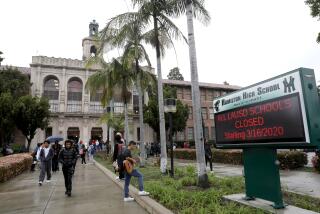$24-Million Plan to Ease Crowded Classes Gets OK
- Share via
To ensure enough seats for an enrollment expected to exceed 600,000 next year, the Los Angeles school board adopted a $24-million plan Monday to purchase portable classrooms and to provide busing for thousands of students whose neighborhood schools are running out of space.
Passed by a 6-1 vote, the plan allows board members to avoid placing more schools on year-round operation until 1988, when, district officials say, no other solution will suffice to ease crowded schools.
Ninety-three of the district’s 618 schools now operate on year-round schedules, which allow maximum use of facilities by rotating groups of students throughout the year. District officials had been considering a proposal to add as many as 78 more schools to the program next July, but that solution provoked passionate outcries from parents on the Westside and in the West San Fernando Valley, where crowding generally is not a problem.
A number of parents who protested the year-round plan at two recent public hearings threatened to remove their children from district schools, while others hinted that some board members might face tough reelection fights in the spring if more schools were placed on year-round operation. A coalition led by a group of Valley parents will attempt to place an initiative on next June’s ballot that would require parents’ approval before a school can be converted to year-round operation.
Five of the seven board members’ terms expire next year.
Board members backed away from the proposal creating additional year-round campuses when they saw a recent staff report showing that it will be possible, for one more year, to accommodate the district’s surging enrollment by other means.
In January, however, the board plans to name schools that will go year-round in July, 1988, as well as decide on a uniform year-round calendar.
It also may consider reopening some of the 23 campuses the district closed between 1982 and 1984. Most of those sites are in the West San Fernando Valley, where enrollment had declined.
This September, the district grew by 11,000 students--to a total enrollment of 590,000--and officials expect another 3,000 to 4,000 new pupils before the end of the school year in June. Most of the growth occurred in Latino and Asian neighborhoods near downtown, along the Wilshire Corridor, in the East San Fernando Valley and the southeast quarter, where immigration and a surging birthrate have caused enrollment to boom for the last several years.
The district, which has not built a new school since 1972, is hoping to get through the next school year by adding 265 more temporary classrooms and busing 9,000 more students.
The plan also calls for changing the integration ratio at certain campuses to allow a higher minority enrollment. Previously, a school was considered integrated if its minority population was between 40% and 60%, but the new guidelines permit a range of 30% to 70%. This allows schools in parts of the district where crowding is most severe to accommodate more minority students.
Board member Jackie Goldberg, whose region includes many densely packed schools near downtown and along the Wilshire Corridor, said it was “with some reluctance” that she was supporting the plan calling for more portables and busing. She is concerned, she said, that existing year-round campuses are unfairly concentrated in minority neighborhoods.
“We should do what we do consistently,” she said, suggesting that either the district should switch the majority of the district’s schools to year-round operation or return the present year-round campuses to a traditional two-semester system.
The sole “no” vote was cast by East San Fernando Valley representative Roberta Weintraub, who said that she could not support the plan’s provision for more year-round schools in 1988.
“I believe we have to go year-round eventually,” she said, “but we need to demonstrate to the community that it is an absolute necessity.”
After the 1987-88 school year, district officials say, no combination of busing, portable classrooms and altered integration ratios will be enough to cope with the rising enrollment, and an extensive shift to year-round schools will be necessary.
More to Read
Sign up for Essential California
The most important California stories and recommendations in your inbox every morning.
You may occasionally receive promotional content from the Los Angeles Times.














